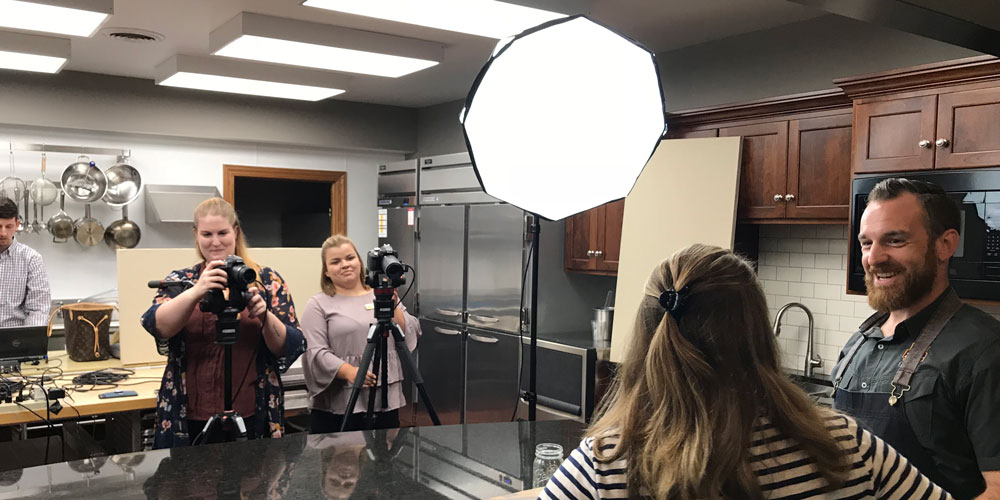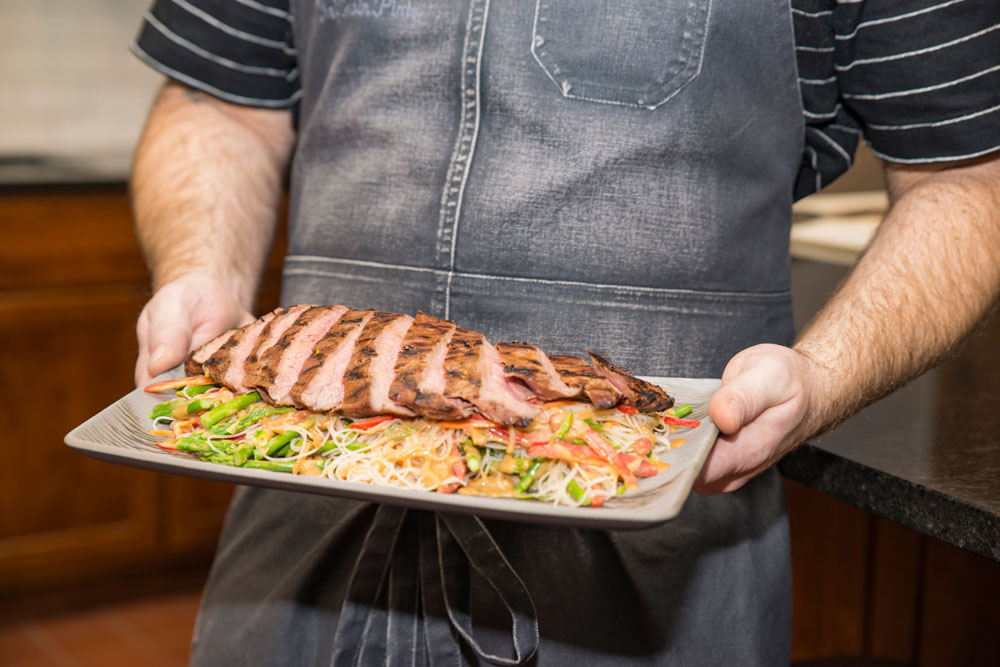With one twist, a burner flicks on. With one cut of marbled meat, flavor agrees to allow no compromise. And with one Certified Angus Beef ® (CAB®) brand Test Kitchen, original beef dishes show their potential to become new family favorites.
The kitchen in the brand’s main building hosted many food industry professionals before the CAB Culinary Center opened its doors. With that center up and running, another innovative and functional space developed.
Kitchen manager Gavin Pinto draws from his background in butchering and culinary arts as the creative mind behind recipe testing and development. Supervising Corporate Chef Michael Ollier collaborates to perfect the recipes they prepare for a consumer audience.
That audience shows avid interest, too: an average of 10,000 daily hits on the recipe section at certifiedangusbeef.com, according to Joyce Gilbert, CAB senior digital marketing manager.

FEARLESS COOKING
To keep shoppers interested in buying beef over other proteins, the CAB team produces recipes for a variety of cuts — those naturally more popular and those that might “intimidate” a home cook.
“Come grilling season, we don’t want to do all strips and ribeyes,” Chef Gavin says. “Those kind of sell themselves. Of course we’ll have some new strip recipes because we want to feature those for summertime, but we’re going to balance it out with some flat iron recipes.”
Those recipes go a long way toward instilling confidence in trying new or less popular cuts.
“It’s giving people that option to have a resource for a top round steak that’s on sale that they may not normally buy, because they don’t know what to do with it,” the chef says. “If they feel more comfortable about it, then they will buy it.”

Value in evaluation
How do these recipes, both popular and resourceful, reach kitchens across the country?
Chef Gavin chats as he chops peppers and onions for a breakfast-skillet potato hash recipe, starting from scratch. All recipes formally begin at a monthly brainstorming session, he says. Corporate chefs gather their best ideas; then it’s off to the kitchen for a preliminary round.
“If I like it, I’ll test it again and have Michael try it,” he says. “Then I have a list of people who like to do home testing.”
Those contacts receive a formally written recipe, much in contrast to Chef Gavin’s original list of ingredients with no exact measurements noted.
As home cooks prepare the dish, they fill out a form, which includes consumer details such as ease of shopping for ingredients, cooking time and eating experience. The test kitchen collects those responses and critically evaluates what changes might be made.
This evaluation proved most difficult for the manager’s favorite and most challenging recipe, Slow Cooker Beef Chili Colorado. Creating the road map for a flawlessly flavored meal with ideally textured beef remains the goal for each recipe.
Photographs and a feature video mark the final steps in the development process.



Ahead of sales
All of this occurs with strategic timing.
“We categorize our recipes depending on the season,” Chef Gavin says. “We’re almost trying to work six months out, knowing what will be popular during those times.”
He captures moments of inspiration for seasonal dishes and waits for the right opportunity to showcase them. Food magazines, connections to other chefs and “foodies” encourage creativity, which in turn prepares the Test Kitchen for what a home cook may request further down the line.
“I want to make sure we’re not missing the boat on anything, recipe wise,” he says.
The balance between high-style cuisine and practicality comes out to a kind of ratio.
“For every more difficult recipe, there’s three more easy recipes.”

Social consumers
As more home-cooked meals come from Facebook feeds rather than Mom’s recipe box, the kitchen engages with most of its followers online.
“Social media really changes the game when it comes to cooking,” the chef says.
Influential home cooks assist with communication over social media, drawing in a different audience than the kitchen reaches alone. To keep the chef audience interested, the Test Kitchen includes some experimenting in the time between recipes, pulling in beef trends from media.
“I’ll see something on the internet that I think is neat, and if it involves beef, we have to do our version,” he says. “I’ll make it, take a picture and put it on social media just for the fact of staying relevant.”
For all the buzz behind CAB brand recipes, producers should know these chefs handle their product with great respect. Knowing how cattlemen and women care for cows and about the high-quality beef they produce adds to job satisfaction in the kitchen.
“Chefs always want to stay something about the product they carry, the product they use, why it’s different, why it’s better,” Chef Gavin says. “There’s so much more to say about it than, ‘oh it’s really marbled beef.’”
Visit the CAB Test Kitchen at www.certifiedangusbeef.com or through Facebook, Twitter, Pinterest, Instagram and YouTube.
This story by Sarah Moyer originally ran in the Angus Journal.
You Might Also Like…
$100,000 Up for Grabs with 2024 Colvin Scholarships
Certified Angus Beef is offering $100,000 in scholarships for agricultural college students through the 2024 Colvin Scholarship Fund. Aspiring students passionate about agriculture and innovation, who live in the U.S. or Canada, are encouraged to apply before the April 30 deadline. With the Colvin Scholarship Fund honoring Louis M. “Mick” Colvin’s legacy, Certified Angus Beef continues its commitment to cultivating future leaders in the beef industry.
Carcass Quality Set to Climb Seasonally
With the arrival of the new year the beef market will rapidly adjust to changes in consumer buying habits. This will remove demand pressure from ribs and tenderloins, realigning the contribution of these most valuable beef cuts to a smaller percentage of carcass value
Raised with Respect™ Cattle Care Campaign Launched This Fall
Raised with Respect™ was developed as part of a strategic cattle care partnership between Sysco and CAB. The collaboration focuses on supporting farmers and ranchers, equipping them with continuing education to stay current on best management practices and helping to increase consumer confidence in beef production.



